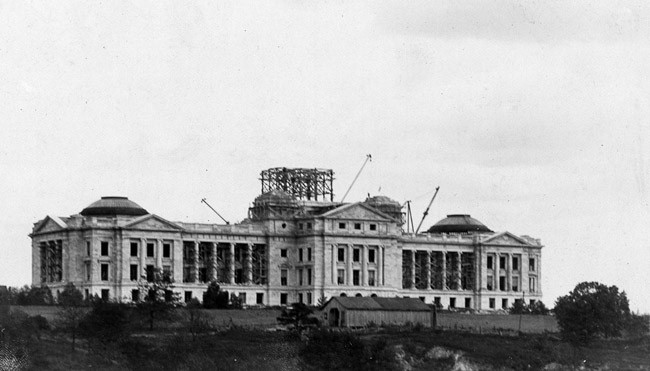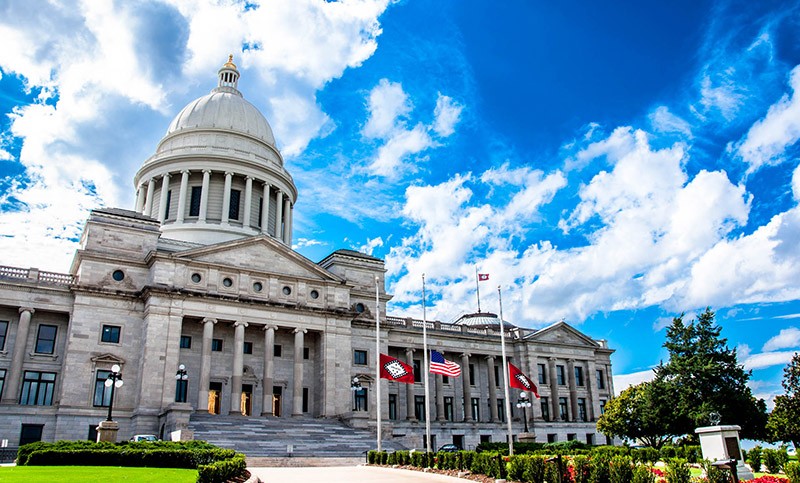Arkansas State Capitol
Introduction
Text-to-speech Audio
Construction on the Arkansas State Capital began in July 1899 and by January 1, 1915, the building was deemed complete enough for the Senate, House, and the majority of elected officials to move in. The building replaced the State House, now the Old State House Museum, which was constructed between 1834 and 1842. The building was designed by architect George Mann and the construction was supervised by Capitol Commissioner George Donaghey. The land that was chosen for the project had been the Arkansas State Penitentiary and it was proposed that the land was too valuable to remain a prison site. Many of Arkansas' most famous politicians, such as Orval Faubus, Winthrop Rockefeller, and Bill Clinton have served terms in this building.
Images
Construction of the Arkansas State Capitol in October of 1910.

The Arkansas State Capitol in February of 2014.

Backstory and Context
Text-to-speech Audio
By the 1890s, it became apparent that the State House, the capitol of Arkansas, was in such disrepair that a new building was greatly needed. Financial insufficiencies within the state government made it nearly impossible for the legislature to approve any new construction. By 1899 conditions in the building became so terrible that after a heavy rainstorm moved through the area plaster began to fall from the ceiling of the Senate chambers."Arkansas State Capitol Building," Encyclopedia of Arkansas, accessed 03/10/2016, http://www.encyclopediaofarkansas.net That was the last straw for the legislature and the process of building a new capitol began.
January 12, 1899, was a big day for the state of Arkansas. On that day the Senate, with the backing of Governor Daniel Webster Jones, introduced a resolution to begin construction on a new capitol. The process of finding an appropriate site for the building began and the governor suggested using the State Penitentiary grounds as a perfect spot for the construction. Governor Jones suggested that the land where the prison sat was too valuable to be used for that purpose. It also allowed for the inmates to be used in the construction process. "Arkansas State Capitol Building," Encyclopedia of Arkansas, accessed 03/10/2016, http://www.encyclopediaofarkansas.net After much deliberation over the site and building process the Senate Resolution was passed and on February 13, 1899, the governor signed the resolution into law.
The state hired two architects to draw up blueprints for the new construction project. George Mann, from St. Louis, and Cass Gilbert, of Minnesota, began drawing up plans and the government proposed that the cost should not surpass one million dollars."The State Capital Building," Arkansas Government, accessed 03/10/2016, http://www.sos.arkansas.gov/statecapitolinfo/pages/default.aspx Mann is credited with being the architect for the state capitol as well as bath houses in Hot Springs, Arkansas. Gilbert was the architect on the capitol buildings of Arkansas, West Virginia and Minnesota in addition to many other buildings as well. George Donaghey, the Capitol Commissioner, oversaw the construction aspect of the project.
By the time that the construction was complete enough for the government to use, the budget had skyrocketed to 2.3 million dollars "The State Capital Building," Arkansas Government, accessed 03/10/2016, http://www.sos.arkansas.gov/statecapitolinfo/pages/default.aspx . In 1911, the first session of the General Assembly was held in a building that still took another four years to complete. The government website points out that the marble on the walls and floors was imported from Vermont, the columnns imported from Colorado, and the grand staircase was imported from Alabama. The building was constructed of limestone from Arkansas and Indiana. "The State Capital Building," Arkansas Government, accessed 03/10/2016, http://www.sos.arkansas.gov/statecapitolinfo/pages/default.aspx By January 1, 1915, the building was being used full time as the seat of government, and it is still in use today.
Sources
Arkansas Government. "The State Capitol Building. Accessed 03/10/2016, http://www.sos.arkansas.gov/statecapitolinfo/pages/default.aspx Encyclopedia of Arkansas. "Arkansas State Capitol Building." Accessed 03/10/2016,http://www.encyclopediaofarkansas.net
